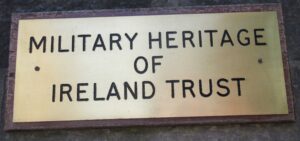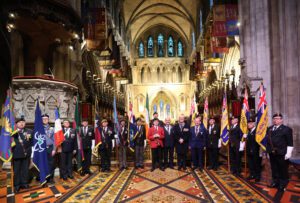Organised by the Michael Collins and Arthur Griffith Commemorative Society, the 92nd Annual Commemoration of General Michael Collins and President Arthur Griffith took place at their burial places in Glasnevin Cemetery on Sunday 17th August.
For the first time in recent decades, the Irish Defence Forces was represented at the ceremony by Lieutenant-General Conor O’Boyle, and provided a Colour Party. As part of the Defence Forces participation, the Sliabh na mBan armoured car was present. Sliabh na mBan formed part of General Michael Collins convoy which was ambushed on 22nd August,1922 at Béal na mBláth in West Cork resulting in his death.
Dr. David Murphy, lecturer in Military History, NUI Maynooth delivered an oration in the Milestone Gallery in the Glasnevin Cemetery Museum.
Among the attendance was Minister for Justice Frances Fitzgerald TD, Minister of State Simon Harris TD, and former Minister for Justice and grand-niece of Michael Collins Nora Owen.
A wreath was laid on Arthur Griffith’s grave by Dr Risteárd Mulcahy whose father General Dick Mulcahy took over command of the Free State army on the death of Michael Collins.
Minister Fitzgerald laid the wreath on the grave of Michael Collins.
Speaking at the event, Minister Fitzgerald “welcomed the fact that the Defence Forces are here today. It’s really important. When we see the challenges to democracy around the world it’s very important to come and honour, as the memorial says, the founding fathers of Irish democracy. We need to value it”.
“What we are honouring today are the foundations of our State…I come from a military family myself and clearly our army plays a very important role in international peace keeping, indeed peace enforcement. That’s part and parcel of what we are”.
Michael Collins
Michael Collins (16 October 1890 – 22 August 1922) was an Irish revolutionary leader, Minister for Finance and Teachta Dála (TD) for the First Dáil of 1919, Director of Intelligence for the IRA, and member of the Irish delegation during the Anglo-Irish Treaty negotiations. Subsequently, he was both Chairman of the Provisional Government and Commander-in-chief of the National Army.
Arthur Griffith
Arthur Griffith (31 March 1872 – 12 August 1922 was an Irish politician and writer, who founded and later led the political party Sinn Féin. He served as President of Dáil Éireann from January to August 1922, and was head of the Irish delegation at the negotiations in London that produced the Anglo-Irish Treaty of 1921, attending with Michael Collins.
Sliabh na mBan

Sliabh na mBan, referred to as ‘Slievenamon’ in its earlier, anglicised form, is one of thirteen 920 pattern Armoured Rolls Royce cars which were acquired from the British by the Irish Free State after the Anglo-Irish Treaty of December 1921. The 1920 car was a slightly modified version of the 1914 pattern Rolls Royce armoured car, which had originally been produced for the British Admiralty (Royal Naval Air Service) during the First World War.
The armoured Rolls Royce cars were deployed in Ireland, in the same theatre as the Peerless and Lancia armoured cars, but were seen as having the edge in terms of mobility, their slim line design later earning the nickname ‘the Whippet’ in Ireland.
What has assured Sliabh na mBan’s special place in history is the fact that it formed part of General Michael Collins’ convoy which was ambushed on 22nd August, 1922 at Béal na mBláth in West Cork. The ambush resulted in the tragic death of General Collins, who was then Commander in Chief of the National Army.
By March 1947, the Defence Forces had been reduced to a strength of 8,803 personnel and there was no longer a place for the armoured Rolls Royce cars in the peacetime Army. They were quietly retired in the Curragh Camp, where unofficial efforts to preserve Sliabh na mBan ensured its survival during the lean years of the late 1940s and early 1950s.
Records at Military Archives show that on 28th April 1954, twelve of the armoured Rolls Royce cars (less their turrets and armoured plate) were publicly auctioned at McKee Barracks, fetching values of between £27 and £60.
However, the Secretary of the Department of Defence, in a letter to the Minister of Finance dated 26th March 1954, mentions the preservation of one Rolls Royce armoured car as a museum piece in the Cavalry workshops, as well as another of the ARR engines for instructional purposes in the Cavalry depot.
Accordingly, the Rolls Royce vehicle YI 6450 – which is ARR 2 – Sliabh na mBan – does not appear on the auction list for that day. The expertise of military and civilian personnel at the Cavalry Workshops since the 1950s has ensured the survival of Sliabh na mBan as a unique piece of Irish military heritage.
Sliabh na mBan retains its historical pride of place as the oldest Cavalry Corps vehicle and one which now remains in perfect working order following extensive refurbishment in the Summer of 2011, under careful supervision of the Defence Forces’ Combined Vehicle Base Workshops.




